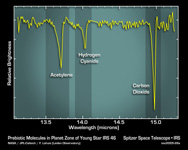
Full Image of GraphThis graph, or spectrum, from NASA's Spitzer Space Telescope tells astronomers that some of the most basic ingredients of DNA and protein are concentrated in a dusty planet-forming disk circling a young sun-like star called IRS 46. These data also indicate that the ingredients -- molecular gases called acetylene and hydrogen cyanide -- are located in the star's terrestrial planet zone, the region where scientists believe Earth-like planets would be most likely to form.
The data were acquired by Spitzer's infrared spectrograph, which split light from the star's disk into distinct features characteristic of a particular chemical. The features, seen here as bumps and squiggles, are like bar codes used in supermarkets to identify different products. In this case, the products are the two DNA and protein precursors, acetylene and hydrogen cyanide, as well as carbon dioxide gas. All three gases are termed "organic" because they contain the element carbon.
The shapes of the features in this spectrum helped pinpoint the location of the gases in the star's disk. A feature's shape reflects the temperature of the gas. By comparison with model spectra, astronomers were able to deduce that the gases are present in regions where the temperature ranges from approximately the boiling point of water on Earth (212 degrees Fahrenheit), to nearly a thousand degrees Fahrenheit. Such hot temperatures place the gases in the star's terrestrial planet zone, which is sometimes referred to as the "Goldilocks" zone because it is just right for Earths.
Acetylene and hydrogen cyanide are some of life's most basic starting materials. If you mix them together in a test tube with water, and give them some kind of surface on which to be concentrated and react, you'll get a slew of organic compounds, including many of the 20 essential amino acids and one of the four chemical units, called bases, that make up DNA.

 Planetary Data System
Planetary Data System













